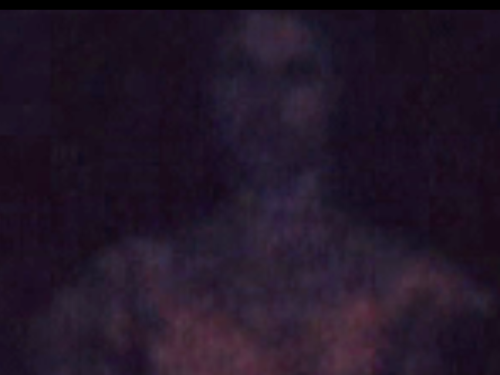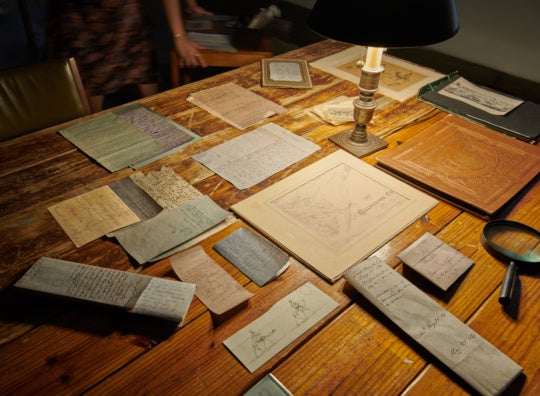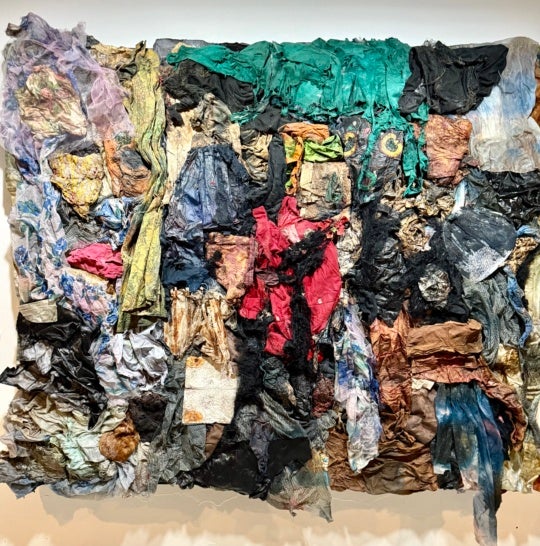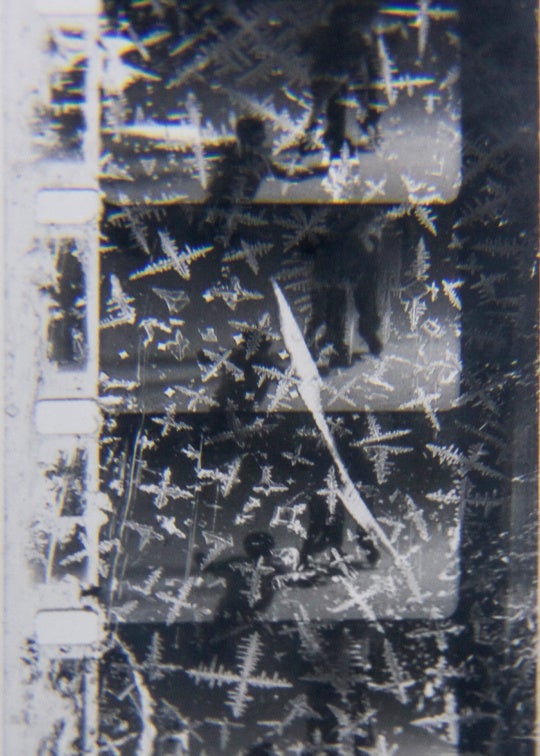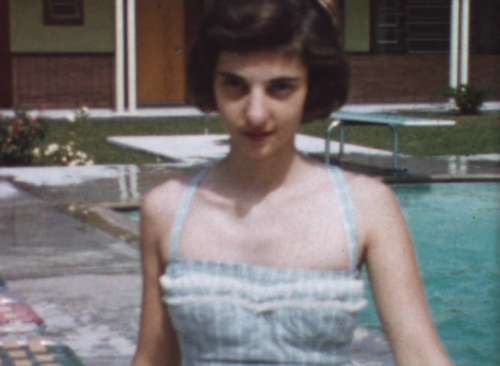
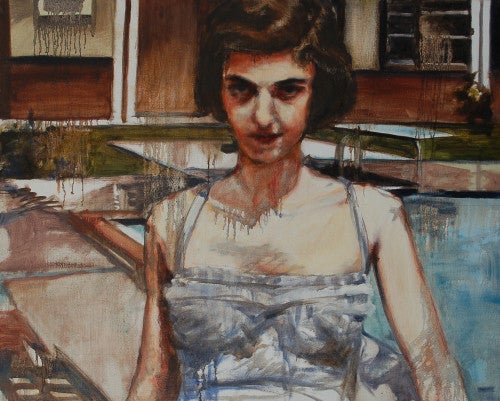
24 by 30 inches.
Familial ties, the pull of memories, and nostalgia are all explored in the exhibition Our Shared Past at the Cummer Museum of Art in Jacksonville, Florida. The show, which is on view through May 25, 2014, features mixed-media works by 34 emerging and established artists who have ties to the region. Guest-curated by Jefree Shalev, a technology systems engineer at the Mayo Clinic, the show’s roots are as intriguing as they are mundane.
A year and a half ago, Shalev’s parents mailed him a box of 30 Super 8 films, which he tucked away, uncertain as to what to do with this parcel of family history. In the fall of 2012, Shalev, 55, decided to transfer the reels to DVD for his folks. Yet before dropping the disk into the mail, he and his girlfriend, photographer Carolyn Brass, decided to watch the films, which average about five minutes each.
Filmed from 1957 through 1968, the reels included such scenes as Shalev’s parents’ wedding, his mother’s graduation from nursing school, his first baby steps, as well as the earliest days of his younger brother and sister. The cumulative effect was staggering. “Upon watching them, I was struck by a combination of sadness and delight,” says Shalev, who is also a poet and photographer. “The sadness came from a sense of alienation from this family of mine. I felt disconnected from them and from my early self.”
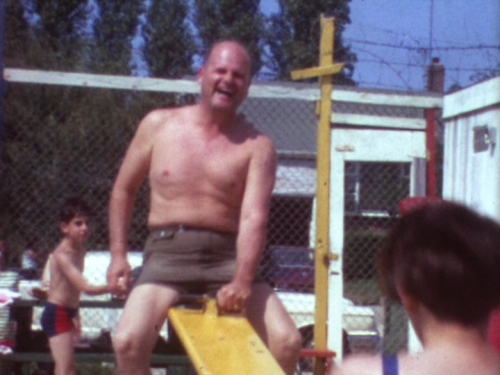
As Shalev and Brass watched the entire collection of films, the distance of time between the past decades and the present day created an emotional distance. “I was able to appreciate the images from a formal perspective and to see the personal as universal.” Shalev then meticulously went through each film frame-by-frame and selected 175 images that he felt “longed to be paintings,” and invited painters with a strong interest in figurative work to take a look at them. “Extra points were given for the artists who also incorporate photographic imagery or are attracted to a nostalgic style.” The artists each interpreted one or two images as they saw fit. “Drawing on their own past, combining it with mine, we have created what I call our shared past,” says Shalev.

The final roster includes 34 artists, each of whom was interviewed on video as the show was put together. Though these videos are not included in the show, Shalev was touched by the artists’ candor as they shared the joyous highs and sometimes brutal lows of their own upbringing—recollections all ignited by viewing these cinematic glimpses of one family’s deep past.
“My family has home movies from the same era as Jefree [Shalev]’s,” explains multi-media artist Jeff Whipple, “so his still-frame images seemed very familiar to me, even though they feature families I’ve never me.” Whipple interpreted the source image that Shalev titled See Saw Fun. “I knew it could be a metaphor for the perception of ‘now’ and ‘not now’,” says Whipple, of his submission Now You See, Now You Saw, a large-scale piece that combines mixed-media with a video loop to great effect.
The collected works are as wide-ranging as the artists’ individual recollections of reverie and family. Jessie Barnes’s Haunting, rendered in dripping oils, features a young woman with an expression that is a mixture of mischief and menace. In Something Blew, Christie Holechek transformed a young bride smiling before a mirror into an explosion of abstraction, a decades-old joyful moment detonated into shards of color and movement.
Mark Creegan’s Too Sensitive is a 32-minute video loop of all 175 of the original source images. “I edited the video to show each image in eleven second increments,” explains Creegan. “The added audio is a recording from 1980 of a psychic reading of my mother; it is one of the only documents I have of her life. In combining these, I wanted to make a very specious, odd take on my family’s past overlap with similar elements from Jefree’s.”
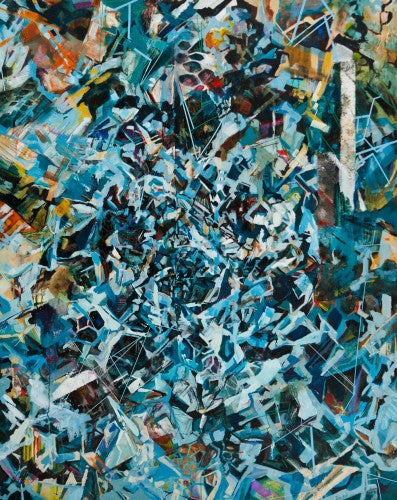
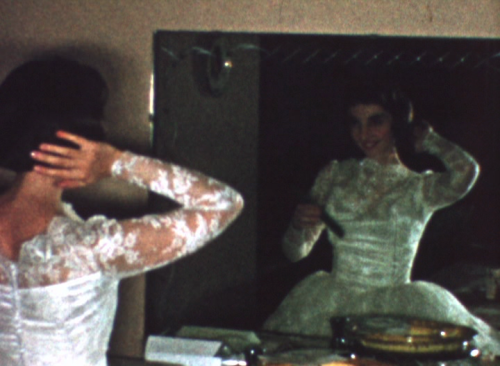
In addition to presenting each artist’s chosen image and finished submission, Our Shared Past features a recreation of a 1960s living room, where a video loop created by filmmaker Jonathan Shepard screens the original films, but with the artists’ interpretation replacing the corresponding frame. The relevant stills can be seen via Viewmasters, an anachronistic device that reinforces the sense of nostalgia.
The moments memorialized in paintings, mixed media, and video work have become tactile analogies of the ephemeral nature of memory and life; at 16 frames per second, the 34 images used in Our Shared Past amount to just over two seconds of lived time. The show ultimately succeeds in combining visual art and memories in a way that makes the latter appear simultaneously private and public. Shalev remains fascinated by the sum total of this experience: “What’s striking to me is that each frame I extracted is now fixed and memorialized, when in fact the moment it portrays was fleeting.”
Daniel A. Brown is a musician and writer living in Jacksonville Beach, Florida. A onetime bassist for Royal Trux and ’68 Comeback, he is also a former arts and entertainment editor for Folio Weekly. Brown also maintains a visual arts site called STAREHOUSE.
